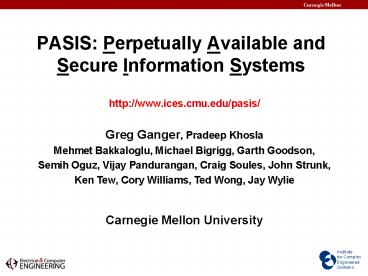PASIS: Perpetually Available and Secure Information Systems - PowerPoint PPT Presentation
1 / 20
Title:
PASIS: Perpetually Available and Secure Information Systems
Description:
Mehmet Bakkaloglu, Michael Bigrigg, Garth Goodson, ... Information should always be available even when some system components are down or unavailable ... – PowerPoint PPT presentation
Number of Views:66
Avg rating:3.0/5.0
Title: PASIS: Perpetually Available and Secure Information Systems
1
PASIS Perpetually Available and Secure
Information Systems
http//www.ices.cmu.edu/pasis/ Greg Ganger,
Pradeep Khosla Mehmet Bakkaloglu, Michael
Bigrigg, Garth Goodson, Semih Oguz, Vijay
Pandurangan, Craig Soules, John Strunk, Ken Tew,
Cory Williams, Ted Wong, Jay Wylie Carnegie
Mellon University
2
PASIS Objective
- Create information storage systems that are
- Perpetually Available
- Information should always be available even when
some system components are down or unavailable - Perpetually Secure
- Information integrity and confidentiality should
always be enforced even when some system
components are compromised - Graceful in degradation
- Information access functionality and performance
should degrade gracefully as system components
fail - Assumptions Some components will fail, some
components will be compromised, some components
will be inconsistent, BUT. - surviving components allow the information
storage system to survive
3
Survivable Storage Systems
- Surviving server-side intrusions
- decentralization data distribution schemes
- provides for availability and security of storage
- Surviving client-side intrusions
- server-side data versioning and request auditing
- enables intrusion diagnosis and recovery
- Tradeoff management balances availability,
security, and performance - maximize performance given other two
4
Step 1 Decentralized storage systems
5
Step 2 Data distribution schemes
- Scheme Algorithm ltParametersgt
- E.g., 3-fold replication replication ltn 3gt
- 1000s of possible choices
- Many different algorithms
- Cryptographic
- Threshold (n shares, any m to reconstruct)
- Hybrids and combinations
- Many reasonable parameters
6
PASIS Agent Architecture
System Characteristics
User Preferences
Tradeoff Management
Client Applications
PASIS Storage Nodes
Multi-read/write Communication
Encode Decode
7
Features of PASIS Architecture
- Security
- confidentiality no single storage node can
expose data - integrity no single storage node can modify data
- Availability
- any M-of-N storage nodes can collectively provide
data - Flexibility
- range of options in space of trade-offs among
availability, security, and performance
8
Engineering survivable systems
- Performance and manageability need to approach
that of conventional systems - to ensure significant acceptance
- Approach exploit threshold scheme flexibility
- achieve maximum performance given desired levels
of availability and security - requires quantification of the corresponding
trade-offs - Approach exploit ability to use any M shares
- send requests to more than M and use quickest
responses - send requests to closest servers first
9
Trade-off management challenges
- Reasoning about security and availability
- specifically, need to translate settings into
configuration rules and limitations - e.g., M gt 0.7N, (N-M) gt 2, M shares cannot be on
same OS - Finding best performing configuration
- within the limitations imposed by first step and
given the expected workload and system components - configuration includes choices of data
distribution scheme, values for M and N and P,
degree of over-requesting, server selection
algorithm, etc - 2-step approach predict performance of any
possible configuration and then search for
optimal choice
10
Trade-off space
Scheme Selection Surface
11
Quantifying the axes
- Performance (MB/s)
- based on simple performance model
- computed with standard performance eval.
techniques - Availability (nines)
- standard fault tolerance math with independent
failures - relative values are useful even if not
independent - Security (Effort to defeat)
- estimate effort involved with possible attack
paths - overall effort is minimum of possible efforts
12
Generation of scheme selection surface
- Quantify performance, security, and availability
of each algorithmparameters - Select best performing scheme for each region
13
Trade-off space
Scheme Selection Surface
14
Selection surface sensitivity
- Models are insensitive to small perturbations of
configuration parameters - Scheme selection surface is different for truly
different configurations
15
Extreme read workload
50 Read Workload
99 Read Workload
16
Security Model Sensitivity
ECircumventCrypto EBreakIn
ECircumventCrypto 2.5?EBreakIn
17
Self-Securing Storage Nodes
- Goal protect data from authorized but malicious
users - both client-side intruders and insider attacks
- How assume all clients are compromised
- keep all versions of all data
- audit all requests
- Benefits
- fast and complete recovery by preventing data
destruction and undetectable modifications - enhanced detection and diagnosis of intrusions by
providing tamper-proof audit logs
18
Where were at
- PASIS architecture and first prototype complete
- Re-implementation of agent in progress
- more efficient, portable, flexible
- and more data distribution schemes and storage
protocols - based on lessons from initial prototype
- Re-implemented multi-versioning storage node
- working on internal space and time optimizations
- investigating how it can be used for intrusion
diagnosis - Trade-off quantification in progress
- measurements and modeling continue
19
Technology Transfer
- Transfer path via CMU Consortia (e.g., PDL)
- 15-20 storage and networking companies
- EMC, HP, IBM, Intel, 3Com, Veritas, Sun, Seagate,
Lucent, Snap, LSI Logic, Hitachi, Panasas,
Network Appliances, Platys Communications - 20 embedded system infrastructure companies
- Raytheon, Boeing, United Technologies, Hughes,
Bosch, ATT, Adtranz, Emerson Electric, Ford, HP,
Intel, Motorola, NIIIP Consortium - Joint Battlespace Infosphere (JBI)
- working with AFRL researchers to understand how
PASIS technologies might fit into JBI
infrastructures
20
PASIS Summary
- Decentralization data distribution schemes
- provides for availability and security of storage
- Tradeoff management balances availability,
security, and performance - and it is good engineering practice!
- Data versioning to survive malicious users
- enables intrusion diagnosis and recovery































